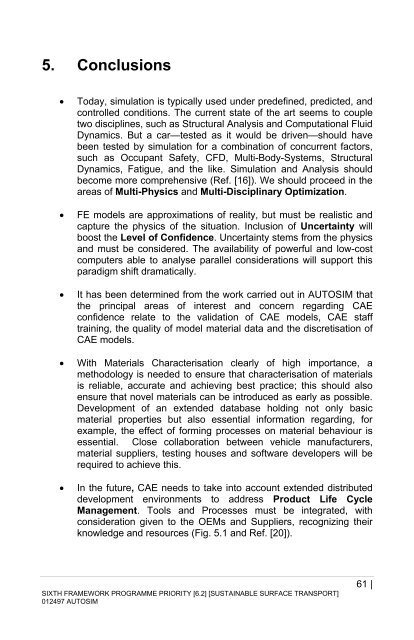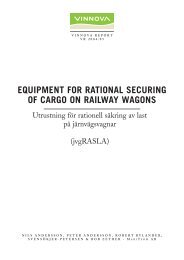Download - Autosim Autosim
Download - Autosim Autosim
Download - Autosim Autosim
You also want an ePaper? Increase the reach of your titles
YUMPU automatically turns print PDFs into web optimized ePapers that Google loves.
5. Conclusions<br />
• Today, simulation is typically used under predefined, predicted, and<br />
controlled conditions. The current state of the art seems to couple<br />
two disciplines, such as Structural Analysis and Computational Fluid<br />
Dynamics. But a car—tested as it would be driven—should have<br />
been tested by simulation for a combination of concurrent factors,<br />
such as Occupant Safety, CFD, Multi-Body-Systems, Structural<br />
Dynamics, Fatigue, and the like. Simulation and Analysis should<br />
become more comprehensive (Ref. [16]). We should proceed in the<br />
areas of Multi-Physics and Multi-Disciplinary Optimization.<br />
• FE models are approximations of reality, but must be realistic and<br />
capture the physics of the situation. Inclusion of Uncertainty will<br />
boost the Level of Confidence. Uncertainty stems from the physics<br />
and must be considered. The availability of powerful and low-cost<br />
computers able to analyse parallel considerations will support this<br />
paradigm shift dramatically.<br />
• It has been determined from the work carried out in AUTOSIM that<br />
the principal areas of interest and concern regarding CAE<br />
confidence relate to the validation of CAE models, CAE staff<br />
training, the quality of model material data and the discretisation of<br />
CAE models.<br />
• With Materials Characterisation clearly of high importance, a<br />
methodology is needed to ensure that characterisation of materials<br />
is reliable, accurate and achieving best practice; this should also<br />
ensure that novel materials can be introduced as early as possible.<br />
Development of an extended database holding not only basic<br />
material properties but also essential information regarding, for<br />
example, the effect of forming processes on material behaviour is<br />
essential. Close collaboration between vehicle manufacturers,<br />
material suppliers, testing houses and software developers will be<br />
required to achieve this.<br />
• In the future, CAE needs to take into account extended distributed<br />
development environments to address Product Life Cycle<br />
Management. Tools and Processes must be integrated, with<br />
consideration given to the OEMs and Suppliers, recognizing their<br />
knowledge and resources (Fig. 5.1 and Ref. [20]).<br />
SIXTH FRAMEWORK PROGRAMME PRIORITY [6.2] [SUSTAINABLE SURFACE TRANSPORT]<br />
012497 AUTOSIM<br />
61 |
















